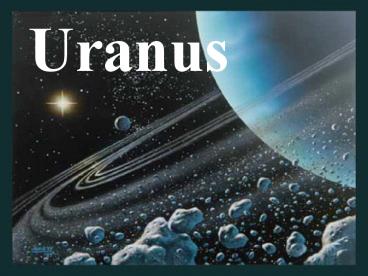Uranus - PowerPoint PPT Presentation
1 / 17
Title: Uranus
1
Uranus
2
Brief History
- 7th Planet from the Sun
- 3rd largest planet by mass
- Named after the ancient Greek god for Heaven
- Discovered in 1781 by William Herschel
- Visited by Voyager 2 on January 24, 1986
3
Statistics
- Distance from Sun 2.87 billions kilometers
19.22 AU - Diameter 51,118 km 4.01 Earth Diameters
- Mass 8.683e25 kg 14.535 Earth Mass
- Satellites 21 named moons and 6 unnamed moons
- Composition mostly rock and ice only about 15
Hydrogen - Atmosphere 83 Hydrogen
- 15 Helium
- 2 Methane
4
Statistics
- Orbit around sun 84.01 earth years
- Day 17 hours 14 minutes
- Color Blue-green color due to Methane gas in
the upper atmosphere which absorbs red light - Density 1.2 g/cm3
- Albedo 0.35
5
Internal Structure
- Similar to Neptunes
- Outer envelop hydrogen, helium and methane
about the mass of 1-2 earths - Mantle water, methane, and ammonia under high
pressure and temperature, about 10-15 earth
masses - Core rock and ice, about 1 earth mass
6
(No Transcript)
7
Uranus Rings
- First 9 rings discovered in 1977
- 11 known rings
- Very dark and faint
- Outermost rings is the brightest Epsilon
- Composed of fine dust to large particles of ice
boulders up to 10 meters in diameter - Most rings 2-12 km across
8
Uranus Rings
- Shepherd moons keep the dust in rings
- Without the moons gravity the rings would spread
apart until they disappeared
9
(No Transcript)
10
Uranus Moons
- 21 named moons and 6 unnamed moons
- Named after writings of Shakespeare and Pope
- Mostly circular orbits except outermost four,
which are much more elliptical - 3 distinct classes 11 small, dark inner moons
- 5 large moons Newly
discovered further out moons
11
Titania
- Largest moon
- Radius 788 km
- Mass 3.49e21 kg
- Distance from Uranus 435,840
- Density 1.7 gm/cm3
12
Oberon
- 2nd largest moon
- Radius 761.4 km
- Mass 3.03e 21 kg
- Distance from Uranus
- 582,600 km
- Density 1.64 gm/cm3
13
Moon Characteristics
- Like our own moon
- Most are covered in craters and trenches
- A few mountains
- Icy
14
Uranus is Weird
- Uranus is tipped on its side
- Result of a planetoid colliding with it
- This causes the magnetic field to be tilted 60
degrees from the planets axis of rotation - The source of the magnetic field is unknown and
the the tail was twisted into a corkscrew by the
collision
15
(No Transcript)
16
(No Transcript)
17
Voyager 2
- Launched on April 20, 1977
- Passed Uranus on January 24, 1986































